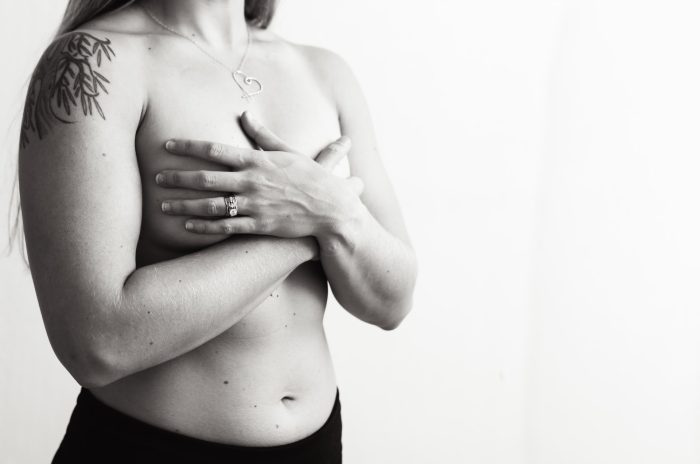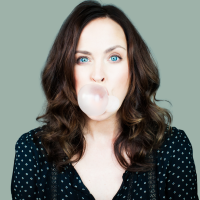Bee Stings. Nose Cones. Knockers. Nuggets. Tits. Bongos. Ta-tas. Double Lattes. It’s your game to pick what you call them.
I’ve got Lorna on the left and Joni Mitchell on my right. But I mean, what do we really know about them? Except that their primary function is to be baby feeders. Our mountainous or perhaps pattycake jugs are just kind of there. Floating. Jiggling. Moving. Lopsided. Round. Weird. Uneven. Perfect.
B-R-E-A-S-T-S: either of the pair of mammary glands extending from the front of the chest in pubescent and adult human females and some other mammals. Also, either of the analogous but rudimentary organs of the male chest, significantly when enlarged.
The breast is an organ whose structure reflects its particular function: milk production for lactation (breastfeeding). The epithelial component of the tissue consists of lobules, where milk is made, which connect to ducts that lead out to the nipple.
A·re·o·la: a small circular area, particularly the ring of pigmented skin surrounding a nipple. Circular and radiating muscles in the areola, a circular disk of roughened pigmented skin surrounding the nipple, causing the nipple to become firm and erect upon tactile stimulation; this facilitates suckling. The areola also contains sebaceous glands to provide lubrication for the nipple during nursing.
I had my third round of breast imaging for this year in February. My biscuits are fiery ladies. Post-second-vaccination this past summer, I had severe lymphatic inflammation. The new bras that I had finally treated myself to because post-lumpectomy was a process of post-op inflammation, scar tissue, and nerves repairing themselves. Overall, my body was working hard to sort itself out.
There were times when a sharp, hot, stabbing pain would shoot through my breast suddenly. Initially, I didn’t know what was going on, and no one had prepared me for World War Z in Lorna, my lefty. I don’t recommend Google, but sometimes you’ve got to break your own rules, and thankfully, I was led to some online chats that educated me about what was going on.
However, what I was experiencing now was quite different. Throughout the summer, I was back to sticking cooled gel packs in my bra; I was getting sharp shooting pains and tingling in my breast, my left axilla, and down the front of my chest. It got to the point where there was an incredible ache every time I breathed in. So like several times before, I made an appointment with my doctor.
Whenever I have to make that call, I think that it will get easier because by now, I know the routine, but it doesn’t. I have to break down what kind of tumour I had in my left breast, was it cancerous, and the pathology of my other four surgeries. And each time, it’s back for more imaging. It’s intimidating, and as much as I, like many, try not to catastrophize, if you’ve been through it before, it’s hard not to spiral into the dumpster dive that is your mind.
I learned that I have a group of twisted cyst-ers in my left boob. They weren’t there last year. It could be because I am 44, and Hormone Hanna is hosting all of the dinner parties—although the current running joke with my doctors is that I have bubbles of Moderna floating in the vortex of my left bosom. I’d also like to point out that many women were experiencing the same post-side-effects of the vaccines. If they aren’t via their knockers, they are experiencing effects with their cycles and all things via the lower lady bits. To all women, my takeaway is this: if we weren’t before, we are now Marvel-ready.
While I get that talking about breast health can be overwhelming and scary, it is necessary. I’m not going to write about statistics; I’m not a doctor. What I do know is my experience. After procrastinating for eight months because fear ruled my world, I finally got in to see my doctor and spent the next three weeks undergoing tests; although benign, as my oncologist said, “You’re lucky. If you had waited any longer, it could have been a point of no return.”
Hearing that was something I kept to myself for a long time. It scared the bleep out of me and spiralled me into a form of functioning anxiety for the next five years. I was terrified that my time was up or that the universe could change its mind within the blink of an eye and say, “Too bad you didn’t understand the assignment.”
Questions circulated in a constant rotation. What is my legacy? What am I leaving behind, and what have I done to contribute to this world? Was it enough? Is who I am enough? You think that you’re awake until life wakes you up, and still, clarity is at the forefront of everything—how you’re living, who’s in your life, and why you chose dysfunction, whether in family, friends, and/or love.
It becomes about finding self-worth and beginning the long journey of loving yourself, knowing that being here and what you do matters. I propelled myself to figure out what kind of life I wanted for myself, who I wanted in my life, who I wanted to be in the world, and through that, I have learned some tough lessons, have felt some young versions of myself die, and found inner peace where there wasn’t before. It was about resigning to control through accepting and processing my grief.
“All I try to do is just root my feet and feel like I have a right to be here. I deserve to be loved. I deserve to be seen. I am loved.” ~ Sarah Niles (Dr. Sharon Fieldstone on Ted Lasso)
The urgency in which I want you to understand this is acute. Please check your breasts. In 2021, five women I know were diagnosed with breast cancer, ranging in ages from mid-30s through to 91. Each with a different type and stage of breast cancer. When it wasn’t what I did for myself, it feels hypocritical to tell you to get to the doctor asap; don’t wait, don’t procrastinate. Early detection is everything, even though that is the crushing undeniable truth.
If you’re feeling scared, please know there’s a surprising amount of off-the-cuff humour in hospitals and doctors’ offices. I’m thankful that this joy exists alongside the darkness in an unexpected place. It invites ease to self and gives breath for the fear to leave, just as I hope reading this does for you.
Also, let’s normalize the conversation around women’s health and doctor visits with each other. What any of us want is the opportunity to be heard, which means active listening from whomever we confide in. If we are making jokes about our health journey, laugh with us. Humour is a gorgeous way of coping. A great way to show up for people is to ask how you can help and what support looks like for that individual.
Scans, but make them fashion
For the first year of scans in between treatments, one of my dear friends didn’t know how to wear a hospital gown (you’re not alone, sister!). To give you a visual, she wore the gown with the ties facing forward, and for the most part, she was somehow making it werk. Until one morning, she comes strolling down the corridor, and I guess the ladies decided that it was their day to strut, and why shouldn’t they get to live their best lives? However, it was a public space (obviously), and it became an unintentional fashion week debut—YASS, Queens! #LiveYourTruth
Leaning in and embracing all of the awkward convos
I had a post-op follow-up regarding one of my incisions. Upon meeting the doctor, I was relieved because I had seen her before and wouldn’t have to explain my health history, so I thought. Once I explained that we had met before and she was so great, I remembered that she liked quarter pounder burgers; she got quiet, took a moment, and said the following. Doctor Deb, “Here’s what I think happened. I think that you saw Dr. Jane because Dr. Jane likes Quarter Pounders, whereas I am Dr. Deb and I like Big Macs. Does that translate? Does that make sense to you?” Me, “Sure.” Half-naked, confused, and amused, I sat on the table—copy Dr. Deb, copy.
Tips
>> Hospital Gown Couture. The ties should do up in the back and use another gown as a housecoat because hospitals are always nippy.
>> Invest in some gel packs that you can keep on rotation in the fridge for breast inflammation. They are legit lifesavers!
>> Sports bras over bras for swollen titties. Just like us, they need space to breathe too.
>> Massage with castor oil. Your technique doesn’t have to be fancy; it’s self-love and tender care that matters.
>> Curate your healing circle. Some masseuses have specific training in working with breast thrivers in treatment, post, and the same with surgery. Osteopaths are magic. I have no idea what they do, but I am here for it! Metaphorically speaking, I float out of there every time.
>> Therapy. That’s it, that’s the tip.
>> Exercise. Whatever brings you joy—whether yoga, Zumba, running, or napping—a combo is a great way to release stress, heal, breathe deeply, and find calm in your mind.
>> Hydrate. Drinking water throughout the day encourages healthy lymphatic function and water retention.
>> Embrace dry brushing! It unclogs pores in the exfoliation process, helping detoxify your skin by increasing blood circulation and promoting lymph flow/drainage.
>> Get acquainted with your Hormone Hannah so that she can let you know what’s up, whether it be a convo with your doc or your naturopath (precisely one that specializes in women’s health and hormones). Your medical team will advise you depending on your course of treatment and where you are on your health journey.
>> There are great apps where you can set up a schedule and reminders to do a self-breast exam, along with videos and diagrams on how to do them and what to feel for.
>> Find your people. Hold them close. Repeat.
Advocate for yourself; you are the only one who will save your life.
Loving yourself is the greatest revolution, and part of that is L-O-V-I-N-G your Mammaries, Cat Flaps, Milk Monsters, Mosquito Bites, Fun Bags, Cha-chas, Fried Eggs, Boobers. They are unique to you; whether you have the breasts you were born with, have had reconstructive surgery, sexy scars, or have beautiful bold tattoos, they are a part of you regardless of what you have been through. Be proud and hold your boobies to the ceiling. Areolas, they make the world go round.
~











Read 2 comments and reply